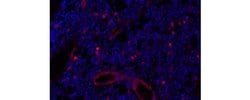Learn More
Invitrogen™ Cutaneous Lymphocyte Antigen (CLA) Monoclonal Antibody (HECA-452), eFluor™ 660, eBioscience™


Rat Monoclonal Antibody
$314.25
Specifications
| Antigen | Cutaneous Lymphocyte Antigen (CLA) |
|---|---|
| Clone | HECA-452 |
| Concentration | 0.2 mg/mL |
| Content And Storage | 4°C, store in dark, DO NOT FREEZE! |
| Applications | Flow Cytometry, Functional Assay, Immunohistochemistry (Paraffin), Western Blot, Immunocytochemistry |
| Catalog Number | Mfr. No. | Quantity | Price | Quantity & Availability | |||||
|---|---|---|---|---|---|---|---|---|---|
| Catalog Number | Mfr. No. | Quantity | Price | Quantity & Availability | |||||
50-985-782
 
|
Invitrogen™
50985782 |
100 μg |
$419.00
$314.25 / Each of 1 Save $104.75 25% Off |
|
|||||
Description
Description: This HECA-452 monoclonal antibody reacts with human Cutaneous Lymphocyte Antigen (CLA). This cell surface glycoprotein is most highly expressed on T cells in the skin. Nevertheless, CLA can also be detected on some peripheral T and NK cells, as well as monocytes, neutrophils and CD1a+ dendritic cells. Studies have determined that this antibody recognizes sialofucosylated glycans and sialyl Lewis x (sLex). CLA, which binds E-selectin and endothelial cell-leukocyte adhesion molecule 1 (ELAM-1), is involved in T lymphocyte infiltration and adhesion at cutaneous sites of inflammation. The HECA-452 antibody has been reported to inhibit sLex binding to E-selectin; however, this property is still under debate in the literature. Applications Reported: This HECA-452 antibody has been reported for use in flow cytometric analysis, western blotting, and immunohistochemical staining of formalin-fixed paraffin embedded tissue sections. Applications Tested: This HECA-452 antibody has been tested by flow cytometric analysis on normal human peripheral blood cells. This HECA-452 antibody has also been tested by immunhistochemistry on FFPE human tissue and can be used at less than or equal to 20 μg/mL.The antibody performs optimally with low pH antigen retrieval but high pH antigen retrieval can also be used. eFluor™ 660 is a replacement for Alexa Fluor™ 647. eFluor™ 660 emits at 659 nm and is excited with the red laser (633 nm). Please make sure that you...
This cell surface glycoprotein is most highly expressed on T cells in the skin. Nevertheless, CLA can also be detected on some peripheral T and NK cells, as well as monocytes, neutrophils and CD1a+ dendritic cells. Studies have determined that this antibody recognizes sialofucosylated glycans and sialyl Lewis x (sLex). CLA, which binds E-selectin and endothelial cell-leukocyte adhesion molecule 1 (ELAM-1), is involved in T lymphocyte infiltration and adhesion at cutaneous sites of inflammation.Specifications
| Cutaneous Lymphocyte Antigen (CLA) | |
| 0.2 mg/mL | |
| Flow Cytometry, Functional Assay, Immunohistochemistry (Paraffin), Western Blot, Immunocytochemistry | |
| eFluor 660 | |
| Rat | |
| RUO | |
| PBS with 0.09% sodium azide; pH 7.2 | |
| Primary | |
| Affinity chromatography |
| HECA-452 | |
| 4°C, store in dark, DO NOT FREEZE! | |
| Monoclonal | |
| Liquid | |
| IgM κ | |
| Human | |
| CLA | |
| Antibody |
The Fisher Scientific Encompass Program offers items which are not part of our distribution portfolio. These products typically do not have pictures or detailed descriptions. However, we are committed to improving your shopping experience. Please use the form below to provide feedback related to the content on this product.
